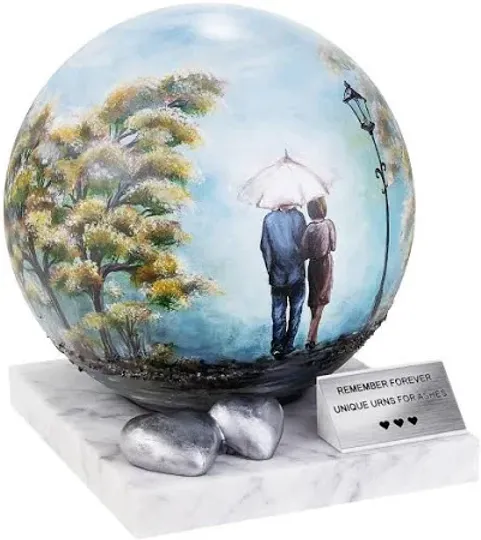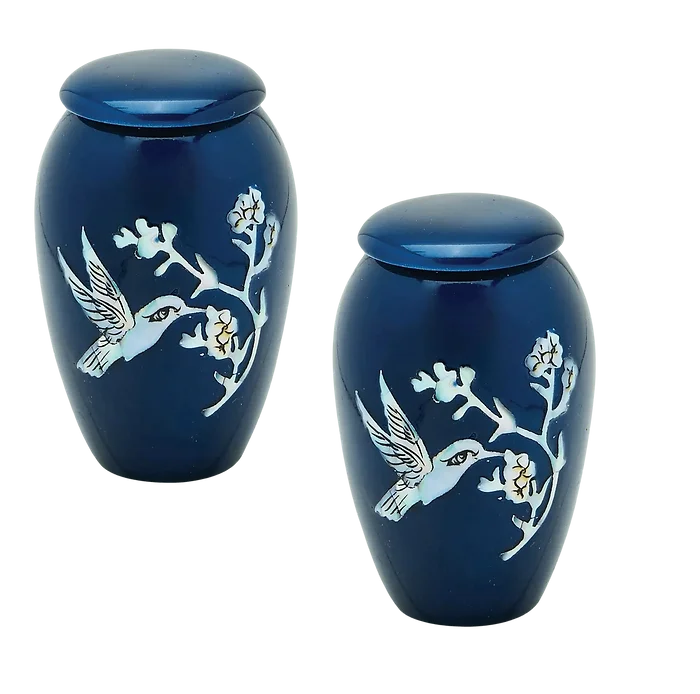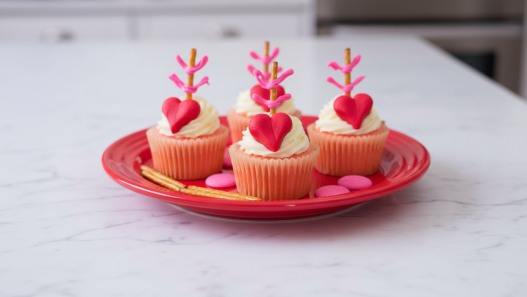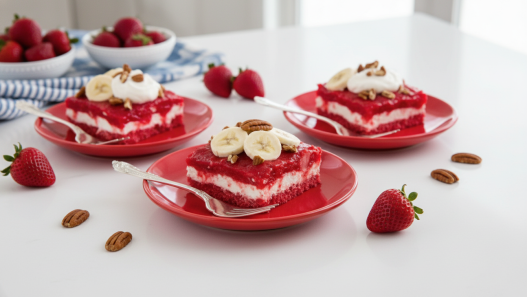Choosing the appropriate urn size for human ashes is an important and often emotional decision. Understanding the various factors that influence the choice will ensure that the urn you select is suitable for your needs. This guide will provide detailed insights into selecting the right size urn, taking into account various factors such as the type of cremation, the individual’s body weight, and the intended use of the ashes.
Urn Sizes and Measurements Needed for Human Ashes
Volume and Capacity of an Urn for Human Ashes
Urns are measured in cubic inches, which reflects the volume they can hold. The general rule of thumb is that one pound of body weight yields approximately one cubic inch of ashes. Therefore, an individual who weighed 200 pounds before cremation will require an urn that holds at least 200 cubic inches.
Standard Size Urns for Human Ashes
Standard adult urns typically range from 200 to 220 cubic inches, accommodating most adults. However, there are different categories of urns to consider:
- Companion Urns: Designed to hold the ashes of two individuals, companion urns usually have a capacity of 400 to 440 cubic inches.
- Keepsake Urns: These smaller urns hold a portion of the ashes, often ranging from 1 to 20 cubic inches.
- Infant and Child Urns: These urns are smaller, with capacities based on the child’s weight.
Factors Influencing Urn Size Selection
Type of Cremation
- Direct Cremation: In direct cremation, the body is cremated without a prior ceremony. The ashes are typically returned in a temporary container, which can help gauge the volume needed for a permanent urn.
- Cremation with Memorial Service: If a memorial service involves scattering or dividing the ashes, smaller keepsake urns might be suitable.
Weight of the Deceased
As mentioned, the weight of the deceased is directly proportional to the volume of ashes. Use the formula: 1 pound of body weight = 1 cubic inch of ash to determine the necessary urn size.
Intended Use of Ashes
- Full Containment: If you plan to store all the ashes in one urn, ensure the urn’s capacity matches or exceeds the deceased’s body weight in cubic inches.
- Scattering: For those who wish to scatter the ashes, smaller scattering tubes or keepsake urns may be appropriate.
- Sharing Among Family Members: Keepsake urns or jewelry can hold a small portion of the ashes, allowing multiple family members to retain a part of their loved one.
Special Considerations When Picking An Urn For Human Ashes Material and Design
Picking the material or an urn for human ashes may depend on budget & intended use. The deceased or your family may have wanted to use an eco urn. Or you may want an urn to display ashes in a cabinet or resting place, therefore you may want to invest in a metal or ceramic urn. Urns come in a wide variety of different materials…
Urn Material Choices
- Metal: Durable and often used for permanent placement in niches or columbariums.
- Wood: Offers a warm, traditional look suitable for display.
- Ceramic: Provides artistic designs but requires careful handling due to fragility.
- Biodegradable: Ideal for eco-friendly burials or scattering ceremonies.
Design Preferences
Urns for human ashes come in various shapes, colors, and styles, from classic to contemporary. Personalization options include engravings, photos, or custom artwork, allowing for a meaningful tribute.
Different Urn Types For Human Ashes
Although a standard urn for human ashes holds one person, the deceased or your family may wish to use a different type of urn. Below we have listed some of the different types of urns available to use.
Companion Urns

Companion urns are specifically designed to hold the ashes of two individuals, making them a popular choice for couples who wish to be together even in their final resting place. These urns typically have a capacity of 400 to 440 cubic inches, which is sufficient to accommodate the ashes of two average-sized adults. Companion urns come in various designs, including side-by-side compartments and single compartments that blend the ashes together. This type of urn can be an especially poignant symbol of eternal unity and shared life.
Keepsake Urns

Keepsake urns are smaller urns that hold only a portion of the ashes. These urns usually range from 1 to 20 cubic inches, making them ideal for families who wish to divide the ashes among several members. Keepsake urns are also used when some of the ashes will be scattered or placed in a piece of memorial jewelry. These urns offer a way for multiple family members to keep a part of their loved one close, allowing for personal remembrance and comfort.
Infant and Child Urns

Infant and child urns are designed to hold the ashes of young children and infants. These urns are smaller than standard adult urns, with capacities that reflect the child’s weight. The design of infant and child urns often includes themes and motifs that honor the innocence and purity of a young life. Selecting an urn for a child can be an especially emotional decision, and many families choose to personalize these urns with engravings or other custom elements to create a meaningful tribute.
Biodegradable Urns

Biodegradable urns are an excellent choice for those who wish to have an eco-friendly burial or scattering ceremony. These urns are made from materials that break down naturally over time, such as paper, salt, or sand. Biodegradable urns are suitable for both water and earth burials, providing an environmentally responsible option for honoring a loved one. They come in various designs, including those that dissolve in water or decompose in soil, ensuring that the remains are returned to nature in a respectful manner.
Detailed Considerations for Urn Materials
Metal Urns

Metal urns are known for their durability and longevity. Common materials include brass, bronze, stainless steel, and aluminum. Metal urns are often chosen for their strength and the ability to withstand the elements, making them suitable for niches in columbariums or burial in mausoleums. These urns can be intricately designed and engraved, offering both aesthetic appeal and lasting durability. The choice of metal can also reflect the personality or interests of the deceased, with options ranging from sleek, modern designs to more traditional, ornate styles.
Wood Urns

Wood urns provide a warm and traditional appearance. They are crafted from various types of wood, including oak, cherry, walnut, and mahogany. Wood urns are often chosen for their natural beauty and the comfort they can bring to families. These urns can be personalized with carvings, engravings, or inlays, allowing for a unique and heartfelt tribute. Wood urns are typically used for display in the home or placement in a columbarium niche, providing a beautiful and dignified final resting place.
Ceramic Urns

Ceramic urns are known for their artistic designs and fragile beauty. These urns are crafted by skilled artisans and can feature intricate patterns, colors, and glazes. Ceramic urns require careful handling and are best suited for display in the home or placement in a protected environment. The artistic nature of ceramic urns allows families to select a piece that truly reflects the personality and tastes of their loved one, making them a meaningful and personal choice.
Biodegradable Urns

As mentioned earlier, biodegradable urns are designed to break down naturally over time, making them an eco-friendly option. They are made from sustainable materials such as recycled paper, salt, or sand, and can be used for both water and earth burials. Biodegradable urns come in various designs, including those that float briefly before sinking and dissolving in water, or those that decompose gradually when buried in soil. This type of urn is ideal for those who wish to minimize their environmental impact and return to nature in a respectful way.
Personalization and Customization Options
Personalizing an urn for human ashes can add significant meaning and emotional value to the final tribute. There are several ways to customize an urn, including engravings, photos, and custom artwork. Here are some popular personalization options:
Engravings
Engravings can include names, dates, quotes, or even images that hold special significance. Many families choose to engrave their loved one’s name and dates of birth and death, along with a meaningful quote or message. Some urns also allow for engraved images, such as a portrait of the deceased, a favorite symbol, or a depiction of a beloved hobby or interest.
Photos
Including a photo on the urn can provide a lasting visual memory of the deceased. Some urns come with built-in frames or areas where a photo can be attached. This option allows families to keep a cherished image of their loved one close, adding a deeply personal touch to the urn.
Custom Artwork
For those seeking a truly unique tribute, custom artwork can be an excellent choice. This might include hand-painted designs, custom carvings, or other artistic elements that reflect the personality and interests of the deceased. Working with an artist to create a custom urn can result in a beautiful and meaningful piece that serves as a lasting memorial.
Special Types of Urns
Military Urns

Military urns are designed to honor veterans and active-duty service members. These urns often feature emblems, flags, or other symbols of military service. They can be personalized with the individual’s rank, branch of service, and other details that commemorate their dedication and sacrifice. Military urns provide a dignified and respectful way to honor the service and commitment of a loved one who served their country.
Religious Urns

Religious urns reflect the faith and spiritual beliefs of the deceased. These urns might include symbols such as crosses, angels, or other religious icons. Religious urns can provide comfort and a sense of peace to families, serving as a reminder of the deceased’s faith and the hope of an eternal afterlife. They are available in various materials and designs, allowing for a personalized and meaningful tribute.
Artistic and Themed Urns
For those who wish to celebrate a loved one’s unique personality, artistic and themed urns can be an excellent choice. These urns might reflect hobbies, interests, or passions, such as music, sports, or nature. Artistic urns often feature creative and intricate designs, making them a beautiful and personal memorial. Themed urns can be customized to reflect the individuality of the deceased, providing a tribute that is both unique and heartfelt.
Jewelry Urns

Jewelry urns are a special type of keepsake urn designed to hold a small portion of ashes. These pieces of jewelry, such as necklaces, bracelets, or rings, allow family members to keep their loved one close at all times. Jewelry urns are available in various designs and materials, including precious metals and gemstones. This option provides a discreet and personal way to remember a loved one, offering comfort and connection through a wearable memorial.
Practical Tips for Choosing an Urn
Consult with Funeral Professionals
Funeral professionals can provide valuable guidance and support when selecting an urn. They can help you understand the different options available and make recommendations based on your specific needs and preferences. Consulting with a funeral director can ensure that you make an informed decision and choose an urn that is both appropriate and meaningful.
Consider the Final Resting Place
The intended final resting place of the urn will influence your choice. If the urn will be displayed in the home, you might prioritize aesthetic appeal and design. For burial or placement in a columbarium, durability and material may be more important factors. Understanding where the urn will ultimately reside can help you make the best choice for your circumstances.
Think About Future Needs
Consider any future needs or plans when selecting an urn. If you anticipate moving or relocating, a more portable urn might be appropriate. Additionally, if you plan to divide the ashes among family members, keepsake urns or jewelry might be the best option. Thinking ahead can help ensure that your choice remains suitable over time.
Set a Budget
Urns are available in a wide range of prices, from affordable options to more expensive, custom designs. Setting a budget can help narrow down your choices and ensure that you find an urn that meets your needs without exceeding your financial constraints. Keep in mind that personalization options and materials can affect the overall cost, so plan accordingly.
Conclusion: Honoring Your Loved One with the Right Urn
Choosing the right urn for human ashes is a deeply personal and meaningful decision. By considering factors such as the deceased’s weight, the type of cremation, the intended use of the ashes, and the desired material and design, you can select an urn that serves as a fitting and respectful tribute. Personalization options allow you to create a unique and heartfelt memorial that honors the life and legacy of your loved one. With careful thought and consideration, you can find an urn that provides comfort, peace, and a lasting connection to your cherished memories.




















